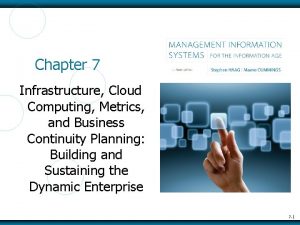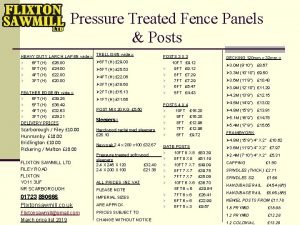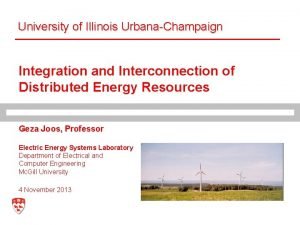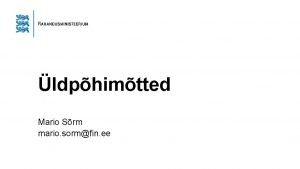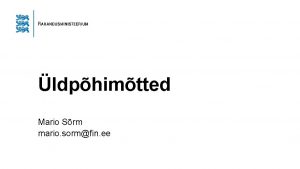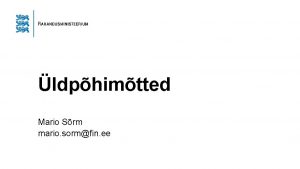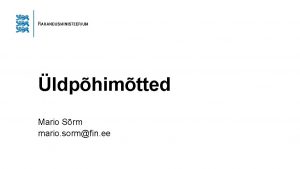Computing response metrics for online panels Mario Callegaro





































- Slides: 37

Computing response metrics for online panels Mario Callegaro Charles Di. Sogra Knowledge Networks DC AAPOR Workshop on Web Survey Methods, September 9 th 2009 © 2009 Knowledge Networks, Inc.

What metrics for what panel Pre-recruited probability-based online panels Ø Response rates can be calculated because the frame is known (AAPOR, 2006) Volunteer opt-in panels Ø “Response rates” cannot be computed (AAPOR, 2007) Ø However, other metrics can be calculated, e. g. completion rate 1

Current status • Volunteer, non-probability (opt-in) panels, widely used in market research, outnumber probability-based Web panels • More and more probability-based online panels being built Ø 2007 -2009 American National Election Studies (ANES) Panel Ø Face-to-Face Recruited Internet Survey Platform (FFRISP, 2008) Ø Dutch Long-term Internet Study for the Social Science (LISS) panel (2007) • Still no officially agreed standard on how to compute response rates for online panels 2

Review of current standards Many efforts and proposals by different national and international organizations: Ø Ø Ø European Society for Opinion and Marketing Research – ESOMAR European Federation of Associations of Market Research Orgs. –EFAMRO Interactive Marketing Research Organization – IMRO Advertising Research Association – ARF quality initiative Bob Lederer proposal endorsed by the American Marketing Association (AMA) Ø Latest effort by ISO (standard #26362) touches on subject 3

Journal recommendations Some journals are giving guidelines on how response rates should be computed specifically for online surveys (not necessarily online panels) Ø Journals enforcing AAPOR standards: (e. g. POQ, IJPOR…) Ø Journal of Medical Internet Research (Eysenbach, 2004): In online surveys, there is no single response rate. Rather, there are multiple potential methods for calculating a response rate, depending on what are chosen as the numerator and denominator. As there is no standard methodology, we suggest avoiding the term “response rate” and have defined how, at least in this journal, response metrics such as, what we call, the view rate, participation rate and completion rate should be calculated. 4

ESOMAR and IMRO examples • ESOMAR (2005) metrics: Ø “Response based on the total amount of invites (% of full numbers) per sample drawn (country, questionnaire) Ø % questionnaire opened Ø % questionnaire completed (including screen-out) Ø % in target group (based on quotas) Ø % validated (the balance is cleaned out, if applicable)” (p. 20). • IMRO (2006) metrics: Ø Response rate is “based on the people who have accepted the invitation to the survey and started to complete the survey. Even if they are disqualified during screening, the attempt qualifies as a response” (p. 13). Ø Completion rate “is calculated as the proportion of those who have started, qualified, and then completed the survey” (p. 13). 5

AMA platform for data quality progress: Platform for Data Quality Progress, Bob Lederer (under AMA umbrella, Nov 2008) 6

ISO 26362: 2009 • Participation rate: ‘number of panel members who have provided a usable response divided by the total number of initial invitations requesting members to participate (p. 3) • Usable response is one where the respondent has provided answers to all the questions required by the survey design • The term “response rate’ cannot be used to describe respondent cooperation for access panels 7

Necessary information to compute response metrics • In order to compute response metrics for online panels we need to understand how panel members are recruited and what stages are used to build a panel • Volunteer-opt-in design • Probability-based design 8

Generalized volunteer opt-in panel design • Stage 1: Encounter, discover, or seek out to join • Stage 2: Provide profile information • Stage 3: Get and do surveys 9

Volunteer opt-in panels: Stages Postoaca, 2007 10

Stages for probability-based online panels • Stage 1: Recruitment from frame • Stage 2: Welcome and get profiled • Stage 3: Active membership, ready for surveys, actual study 11

Common steps in building a probabilitybased panel 1. Recruitment Rate (RECR): the recruitment of potential panel members Ø Recruitment rate calculation will depend on the recruitment mode: face -to-face, telephone, mail 2. Profile Rate (PROR): empanelling recruited persons Ø This stage counts panel members that answered their profile survey, generally a questionnaire collecting background information and welcoming respondents to the panel Ø The computation of the profile rate (a. k. a. , connection rate) will depend on the data collection mode Ø Profiled members are considered to be “active members” in the pool from which study samples can be drawn 12

Probability-based design features Implications for computing response rates 1. Single recruitment cohort (one-time effort) vs. multiple recruitment cohorts (on-going recruitment) 2. Within-household selection to recruit one person vs. whole household recruitment of all eligible persons 3. The data collection mode used for non-internet households (no access to online surveys at time of recruitment) 13

Methods of dealing with non-Internet households 14

Probability- based web panels: Recruitment 15

Probability- based web panels: Profile 16

Probability- based web panels: Actual study Same design for volunteer-opt-in panels 17

Active panel dynamics 18

Stage 1 of probability-based web panels IC Recruitment (RECR) = Rate IC + (R + NC + O) + e(UH + UO) Example: P_RECR =. 4 x 100% = 40% Refusal (REFR) = Rate R IC + (R + NC + O) + e(UH + UO) IC = Initial consent R = Refusal UH and UO = Unknown if household or unknown “other” NC = Non-Contact O = Other non-interview e = Estimated proportion of unknown eligibility cases 19

Stage 2 (more likely for probability-based panel) Profile Rate (PROR) = (I + P) + (R + NC + O)* Example: PROR =. 6 x 100% = 60% Refusal to Profile (REFP) = R (I + P) + (R + NC + O)* I = Profile survey complete P = Profile survey partial but acceptable * Opt-in panels may not know the denominator components. 20

Stage 3 Specific Study Rates Completion Rate (COMR) = (I + P) + (R + NC + O) Example: COMR =. 7 x 100% = 70% -off Rate (BFR) = Study Refusal (SREF) = Rate BF Break (I + P) + BF R (I + P) + (R + NC + O) BF = Break-offs -- when the number of answers is below the definition of partial interview, it can be considered a break-off. R = Other than for the break-off rate, R includes break-offs as refusals 21

Cumulative Response Rate Only for pre-recruited probability-based online panels A multiplicative function Cumulative RR (CURR) = P_RECR x PROR x COMR Example CURR=. 4 x. 6 x. 7 =. 168 x 100% = 16. 8% Cumulative RR 2 (CURR) = P_RECR x PROR x RETR x COMR Example CURR 2=. 4 x. 6 x. 8 x. 7 =. 134 x 100% = 13. 4% P_RECR = Person recruitment rate PROR = Profile rate COMR = Completion rate for the single study RETR = Retention rate 22

Computing CUMRR with 1 cohort RECR PROR The computation of a CUMRR is straightforward when the panel is built with a single recruitment cohort RETR COMR Study Respondents 23

Computing CUMRR with 3 cohorts Unequal cohort contributions to a study sample selected from among all active members 24

Formulas dealing with multiple cohorts (1. ) RECR, PROR, RETR are calculated as the weighted average of the size contribution of each cohort Example to calculate RECRtotal Where Wcn = the number of cases contributed to the sample from cohort n 25

Example of RECR with 3 cohorts Size in the final sample Recruitment rate (RECR) Cohort 1 Cohort 2 Cohort 3 200 100 50 . 35 . 27 . 15 26

Formulas dealing with multiple cohorts (2. ) 27

Full example with 3 cohorts Cohort 2 100. 27. 65 Cohort 3 50. 15. 70 ___Rtotal Size RECR PROR Cohort 1 200. 35. 57 RETR . 50 . 67 . 85 . 599 . 299. 611 Assume a survey completion rate (COMR) of. 713 28

Computing completion rate (COMR) when multiple data collection modes are used Completion rates need to be computed separately for each mode Ø Web survey Ø Mail, phone or IVR These rates should also be combined as a weighted average 29

Technical condition in order to compute response metrics • In order to compute response metrics each panel organization must keep an historical database with rates for each member • More specifically for probability-based online panels it is necessary that: Ø Each panel member ever recruited must have a record of his/her: – Recruitment rate cohort value – Profile rate cohort value – Retention rate cohort value 30

Which formula for which panel? Metric Recruitment Refusal to be recruited Probabilitybased Yes Volunteer opt -in N/A Profile Refusal to profile Screening Eligibility Completion Break-off Refusal Cumulative Response Yes Yes Maybe Yes Yes Yes N/A 31

Which formula for which panel? II Metric Pre-recruited Volunteer Attrition cross sectional Attrition longitudinal Yes Yes Reinterview Yes 32

Dutch study (Vonk, van Ossenbruggen, & Willems, Esomar 2006) Panel Management or Manipulation? 33

Some factors affecting each rate Recruitment rate Ø Recruitment methods Ø Incentives Profile rate Ø Incentives Ø Panel management efforts Retention rate Ø Time elapsed since recruitment Ø Incentives Ø Panel management efforts Survey completion rate Ø Field time Ø Incentives Ø Reminders 34

References • Callegaro, M. and Di. Sogra, C. (2008). Computing response metrics for online panels. Public Opinion Quarterly, 72, pp. 1008 -1032. • Di. Sogra, C. and Callegaro, M. (forthcoming). Computing response rates for probability based web panels. In American Statistical Association (Ed. ). Proceedings of the joint statistical meetings: section on survey research methods [Cd-Rom]. Alexandria, VA: American Statistical Association. 35

Future work • Recruitment level computed at a household or at a person level (when recruiting multiple members per household) • Attrition rates for cross sectional design • Attrition rates for longitudinal designs • Response rates for longitudinal designs 36
 Roberta callegaro
Roberta callegaro Giorgia callegaro
Giorgia callegaro Tsf call center metrics
Tsf call center metrics Conventional computing and intelligent computing
Conventional computing and intelligent computing Natural and forced response
Natural and forced response What is natural response
What is natural response Primary immune response and secondary immune response
Primary immune response and secondary immune response Thermolite solar panels
Thermolite solar panels Npua panels
Npua panels Monson cars
Monson cars Flixton sawmill price list
Flixton sawmill price list Precast concrete veneer
Precast concrete veneer Wholesale solar panel efficiency
Wholesale solar panel efficiency Flixton sawmill price list
Flixton sawmill price list Vb.net splitcontainer 3 panels
Vb.net splitcontainer 3 panels Everest solar panels
Everest solar panels Hmlp hingham
Hmlp hingham 2-wires door entry system design
2-wires door entry system design Modular ot flooring
Modular ot flooring Scip panels
Scip panels Pv heater dc
Pv heater dc Sopray solar panels
Sopray solar panels Scheuten solar panels
Scheuten solar panels The future of solar energy
The future of solar energy Vm1650 centrifuge basket
Vm1650 centrifuge basket Transite roof help
Transite roof help Iteratio n5
Iteratio n5 Solar panels mc gill
Solar panels mc gill Social networks and groupware in cloud computing
Social networks and groupware in cloud computing Kontinuitetshantering
Kontinuitetshantering Typiska novell drag
Typiska novell drag Tack för att ni lyssnade bild
Tack för att ni lyssnade bild Ekologiskt fotavtryck
Ekologiskt fotavtryck Varför kallas perioden 1918-1939 för mellankrigstiden?
Varför kallas perioden 1918-1939 för mellankrigstiden? En lathund för arbete med kontinuitetshantering
En lathund för arbete med kontinuitetshantering Kassaregister ideell förening
Kassaregister ideell förening Personlig tidbok
Personlig tidbok Sura för anatom
Sura för anatom


